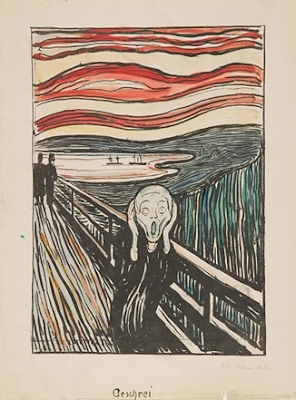I CONSTRUCTION
Dimension: W 1m / L 1m /H 3m
Elements
3 Space Frame Elements (1m/1m/1m)
12 Acrylic Color Plates 5mm with one side with two-way mirror Film)
Media
1 Alu D-Bond Plate 6mm with QR Code Print*
*(QR with The Scream at the center: QR Code links to Engagement App)
II INFORMATION
Description
SCREAMBOX: This element is designed to present a case study on "The Scream" by Munch, which has been undergoing changes in color due to aging. The space frame elements serve as a mount for the 13 plates used in the installation. Twelve of these plates are one-way mirrors with colored film on their back, while the remaining plate, located at the top of the cube, is a print plate containing a large QR code. This QR code can be scanned to display an image of "The Scream" (or an abstraction thereof) on the visitor’s mobile phone, which can then be used to project light inside the element. The mirror plates are mounted on swivels, allowing them to be reversed and changing the direction of the one-way mirrors.
On two sides of the space frame, the panels open as doors to allow visitor entry; on the other sides, the panels open as windows. This mounting method enables the reflections in the mirrors to become dynamic, changing position through direct manipulation by the public and visitors inside the box. The recreation of the color content and emotions depicted in the painting is achieved through a periodic flash created by the app, which bounces light off the mirrors inside and simultaneously increases the brightness of the color panes, recreating a sunset scene. The emotions akin to those in the painting are evoked by the effect of confinement and the impact of a flash at 14 cycles per second (cps), known to produce phosphenes—visual patterns that appear when the eyes are closed, often experienced as bright, colorful geometric shapes and flashes.
Technical Elaboration
The element is designed to exploit the emotional depth contained in the painting and have the visitor experience it firsthand through emotional transfer made possible of heighten sense of self presence brought by infinite reflection from the mirrors combined with extending the color palette from the painting onto the visitor, which they then experience in their own reflections.
The situation creates a sense of emotional tension in the viewer, because the space in the box is tight and brings with it a claustrophobic effect and the images confront the viewer as they animate through the light and produce a sense of overwhelming similar to what the artist may have experienced himself and which inspired him to create the painting.
A QR code is mounted on the first Space Frame on each of the sides of it so that it can be accessed by more than one person at a time. It opens the case study app.
III ENGAGEMENT APP
Description
ScreamBox: An app that explores non visual color perception using the color pallette of Edvard Munch's "The Scream," where users experience a kaleidoscopic animation and adjust the color palette by producing a scream.
>Application opens Instructions appear on the screen for the user to read;
>User presses Play/Pause to play the animation (while eyes closed).
>User adjust volume as needed
IV CASE STUDY ARTWORKS
 |
The Scream, Edvard Munch Munch Museum, Oslo ©Munchmuseet |


